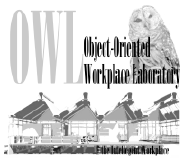

The goal of the OWL (Object-Oriented Workplace Laboratory) system is to provide an object-oriented and component-based framework that supports the engineering of applications for the design, simulation, construction, and operation of buildings with more efficient use of building facilities. OWL is based on a software architecture using a combination of web and object technology. It offers location transparent and manufacturer independent access to a variety of facility control systems, and allows users to define "scenes" to adapt their work environment.
In this paper, we describe the requirements, system design and a conceptual prototype of the OWL framework. We discuss how the application of design patterns and component technology impacts the framework to support the maintenance of corporate sites globally distributed across the world. A conceptual prototype of OWL written in Java is operational, managing distributed facilities at the Intelligent Workplace at Carnegie Mellon University and at the Technische Universität München.
The health, well-being, motivation and productivity of office workers (over half of the U.S. work force of 120 Million people) depend significantly on the pleasant personalized arrangement of their office interior. Examples would be quantity and quality of lighting, including daylighting systems. Glare (reflected or indirect), illuminance and contrast values are critical.
OWL attempts to deal with some of these problems, and provides users with a high degree of control over their work space in a cooperative building. From their user interface, they can request changes in the temperature, light level, and other aspects of the environment. These changes are then effected through adjustments in exterior louvres, internal lighting systems, and the HVAC system. Through a network of environmental sensors located in each work area, an energy-efficient adjustment of building climate systems can also be formulated and executed by OWL.
|
|
Today there are several different control system solutions available for facility management, such as the European Installation Bus EIB developed by Siemens or Luxmate from Zumtobel AG. The problem is that these solutions cannot cooperate. A company might start with a homogenous control system but due to evolution and mergers with other companies, it soon faces the problem of heterogeneous control systems globally distributed over several locations. Another shortcoming with the current solutions is that the level of control is coarse. For example, with the Zumtobel Luxmate system a facility manager can group several lamps, adjust the lightness, and map them to a specific switch. But each switch can only be mapped to a single group. Multiple users cannot allocate switches with their own groups.
|
|
|
OWL is independent from proprietary control systems and allows a flexible customization of the office interior by the user. We introduce a layer of abstraction that is built on top of the proprietary control systems which are hidden from the users unless they need to see them, like a Luxmate engineer that has to check Luxmate controlled facilities. Controlled objects can form a group and be associated with commands that change their settings. We call this a scene. Scenes can be changed dynamically and belong to users. Users can adapt their environment, starting with a default environment set by a facility manager.
|
A conceptual prototype demonstrating some of the capabilities of OWL has been developed for two distributed locations: the Intelligent Workplace located at the Carnegie Mellon University, and the Intelligent Home lab located at the Technische Universität München. The prototype provides access to two Luxmate lighting control systems via a Web based user interface.
The prototype was developed with JDK 1.1. For the implementation of the OWL bus we used remote method invocations which we tested with CORBA 2.0 and RMI from Javasoft, respectively.
A demonstration is available. Two movies show the scenario 1 "Control" where the OWL user Ralf is working on his computer. One movie shows the user interface of the prototype, and the recording of the Luxmate lighting box in parallel. The second movie shows Ralf with his laptop in the lab. With his OWL based facility management application he controls each light of a Luxmate lighting system. The user interface shows a detailed 2D floor plan of the OWL controlled building with the lights symbolized as boxes in the upper left corner. The upper right corner contains the control buttons for the certain lightbulb that is actually selected. The lower left corner contains control output, and the lower right corner is for 2D navigation through the building. The movies show how Ralf switches several lights on and off. When a light is switched off the light icon is gray, when it is switched on it changes to green. When a lightbulb is out of order (demonstrated by Ralf removing the lightbulb) OWL announces it to the user by turning the light icon red. OWL also knows the location of the lightbulb from the CAD drawing, and moves the focus of the detailed map to that location. When Ralf replaces the lightbulb the light icon turns green.
Two prior Praktika (OWL I and OWL II ) have developed two Java prototypes, one based on CORBA, the other based on RMI, demonstrating the management of lighting control for a specific manufacturer.
A former version of OWL is subject in Bruegge et al : Turning Light Bulbs into Objects. OOPSLA97, Addendum to the Conference Proceedings, Atlanta, October 1997.